June 29, 2024 – Volume 26, Issue 6
In This Issue
- Flanigan’s Net Positive: Escape from Alcatraz!
- U.S. Hits 30% Renewable in April
- Highway Noise Barriers with Integrated Solar
- Integrating Energy Vault into Skyscrapers
- The Cooperative Utility that Could
- AI’s Energy Intensity
- Climatarians and the Quest for Climate-Friendly Foods
- Lufthansa’s Environmental Cost Surcharge
- Flanigan’s Eco-Logic Podcast Updates
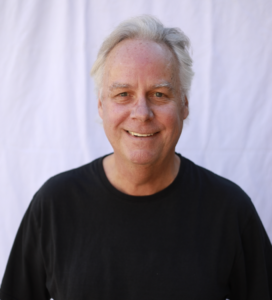
Flanigan’s Net Positive: Escape from Alcatraz!
No, not me. And no jailbreak. Off we went to San Francisco to cheer on Matlock, daughter Kristin’s boyfriend who was competing in the San Francisco, Escape from Alcatraz Triathlon. Matlock’s a super guy, works hard. He’s a serious biker. I was impressed that he had committed to himself for some years to take on this magnitude of a race, its months of workouts and preparation. This year he applied, qualified, and accepted to compete in the Escape from Alcatraz!
Midway through his training, he admitted second thoughts. What had he gotten into? He grew up in Utah; swimming is not his thing. What ocean? But forget that! Many of us – including his family from Utah – mother, father, two sisters, a niece and nephew – plus our LA-based support team, and his best friend from college – committed and made plans to come to San Francisco to watch him compete. Terry and I hitched a ride. We stayed on California Street at the Omni, the cable cars passing by, headed up Nob Hill.
Other than competing in a few 5 – 10 kilometer runs, and despite my love of sports, I had never been around races. My impression of triathlons was based solely on an inflight documentary of the Iron Man race in Hawaii. Craziness. To me, one segment of the three that make up the triathlon would be major and certainly enough. But two, three?
Matlock had trained and practiced two segments… but this would be his first shot at all three legs. Escape from Alcatraz consists of a 1.5-mile swim in rough waters, an 18-mile bike ride, capped off with an 8-mile run punctuated by the infamous “sand steps” where contestants climb from Baker Beach up 400 uneven log and sand steps.
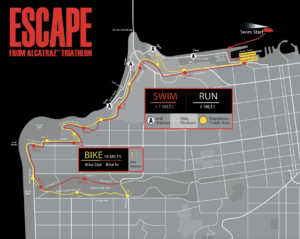
The Escape from Alcatraz this year had ~2,000 contestants. The first leg of the triathlon was a swim from Alcatraz to Fort Mason. Burrr. And this spot is known for its currents. For months, Matlock had worked on his swimming in the YMCA pool and then in the ocean.
“Team Matlock,” the families, met at 6:30 in the morning at the race’s hub and finish, the main transition area at Marina Green. It was chilly in the park, an overcast morning. We were impressed by the bike storage area of the park. All the bikes had been there overnight. The area was fenced off and with lots of security. The bikes, along with bags of gear – shoes, gloves, helmets, etc. – were ready for their riders’ quick transitions from initial run to bike, then later from bike to run.
From the park we could see Alcatraz, the start of the race. As we waited for the start, clutching warm tea and coffee, we watched a massive container ship coming in under the Golden Gate, then wrapping around the northern side of Alcatraz well away from the swimmers. Then at about 6:45 we saw the giant riverboat – the San Francisco Belle – taking the swimmers to the start. She circled Alcatraz and then positioned herself at the start of the race. Contestants would start the triathlon by diving off the Belle. There were lots of kayaks in the water, plus police boats with blue lights, and officials on jet skis.
At 7:00 sharp, with the naked eye, the Marina Green crowd assembled saw the splashes of the racers diving off the Belle, into 52 degree water, and beginning the race. We’d been told that the professionals – yes, there is a circuit of sponsored triathletes – went first, along with others who qualified. All participants unloaded in eight minutes, 2,000 strong leaping into the current and cold water. Wetsuits were mandatory for the open-water swim.
We left the vantage spot for the start of the race, and at first we ambled toward the Marina Green Beach where the swimmers would get out of the water, just west of the St. Francis Yacht Club. Then we moved fast as we saw the lead swimmer nearing the swim’s completion! The word spread that they had an amazing current in their favor. Best ever!
Before we knew it, we saw the race leader jogging briskly in his wetsuit toward the bike staging area. He looked great. Zero body fat. Wow. That was fast. Before we knew it, just as we got to the beach, there was Matlock coming out of the water with a big grin on his face! It had taken him only a half hour. He’d planned for much more time in the water.
Elation among Team Matlock there was. He had done the swim in record time… way faster than he anticipated, and likely in the top third of all contestants. We’d learn later from him and others that it was super choppy, and swimmers were getting mouthfuls of water while being kicked by fellow swimmers.
Despite that, and to his mother’s relief, he was ashore, swimmers removing their head pieces, and unzipping wetsuits. We cheered him on as he tucked into a mini-transition staging area, whipped on some running shoes, for a half-mile “warm-up” run back to the race hub. That’s where we went next.
The race got us fired up. Everyone was fired up. The crowd moving… pulsing even, shifting to get to the next vantage point. Cheering… cheering them all on was consistent. Matlock said that throughout the biking and running course, there were people cheering them, propelling them.
We were struck by the age diversity of the triathletes, and the apparent breadth of fitness. Not everyone was buff… but everyone looked excited and fulfilled, each reeked of determination. And each and every one was the recipient of untethered applaud. Youth and boundless energy passed us, as did proofs of pride and wisdom and experience. We scurried from one vantage point to another.
Biking is Matlock’s thing, his preferred sport, and the bike route up to Golden Gate Park is territory that he knows well. He lived in San Francisco, pre-pandemic. He looked good coming back from the bike ride, waving to us and he wheeled into the transition area. His spot to leave the bike was near the sidewalk, and we were able to speak to him after the ride. He looked good and smiled…. and said flatly, “I’m tired.” What could we say? How about an 8-mile run? Off he went.

He made it! The finish was exhilarating as we witnessed a runway of so many exhausted contestants. Yet each had a wonderful look. They were at the end. They basked in the deserved the cheers. Smiling broadly, sweating profusely, finding their loved ones, fists in the air. And then through the finish with names and hometowns called out on the PA system. Lots of applause, such an uplifting time, bonding with those around us. As their loved one came into view, and passed up by, we all cheered as if he or she were ours too! Big cheers, cowbells ringing.

The pinnacle of my emotions was simple. I’ll never forget Scott, Matlock’s dad, hugging his son at the finish. “I am proud of you son,” he said, wiping away his tears. He’d been just blown away by the event and his son. A mom elated too, plus an exceptional and devoted and supportive girlfriend.

The sun was shining at the finish, the contestants being fed a hearty catered meal… all manner of friends and family and dogs milling about, basking in the post-race bliss. The runners were clearly exhausted, but also clearly pumped up. They looked surprisingly good… ready later for a well-earned shower and nap no doubt.
Never thought it would mean so much to me. But the race was a high for me, for us all. It felt good to bond in our supporting mission, to be part of the team, among Matlock’s family and friends, and to support and salute his huge effort. Matlock did really well. What an accomplishment. What an inspiration to be in the presence of devoted athletes, pushing their bodies to excel. Hats off Matlock, to you and all your fellow triathletes!
Quote of the Month
“This partnership with Energy Vault is a commitment not only to accelerate the world’s transition away from fossil fuels, but also to explore, together, how the architecture of renewable energy can enhance our shared natural landscapes and urban environments.”
U.S. Hits 30% Renewable in April

The pace of change continues to astound me. Now, news from the U.S. Energy Information Administration. Its Monthly Energy Report, documents that renewables provided more than 30% of all U.S. electrical generation in the month of April. Yes, in April wind out-produced coal by a factor of two. In April, solar surpassed hydro in terms of generation. And together, wind and solar exceeded nuclear power. What a month!
Solar grew overall by 25.4% in the first four months of the year compared to the first four months of 2023. Solar is the fastest-growing source of electrical production. Utility-scale solar expanded 28.4%; small scale solar grew by 19.3%.
In April, renewables grew by 13.5% compared to April 2023, and reached 31.0% of the U.S. total generation, up from 28.4%. And the news gets brighter, according to Ken Bossong, head of the SUN DAY Campaign, the outlook is good: “EIA’s latest data do not yet include the sunniest days and weeks of the year and it can therefore be assumed that more records will be broken by renewables in the months ahead.” Stay tuned for our next milestone: 33%?
Highway Noise Barriers With Integrated Solar
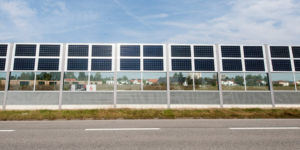
Image Courtesy of Fraunhofer Institute for Solar Energy Systems ISE
A German research team is testing new module concepts, integrating solar into sound walls along busy highways and railways. The team is working on both new construction applications, as well as add-on solutions.
Fraunhofer Institute for Solar Energy Systems ISE in Freiburg, Germany, is leading the effort and is exploring new designs and concepts for solar along roadways and railways as sound barriers. The study is known as PVwin and began in 2020. Now the research is in its outdoor field-testing stage. Tested are five different solutions in sound absorbing walls, some using prominent baffles.
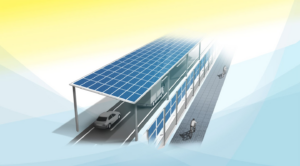 Image Courtesy of Fraunhofer Institute for Solar Energy Systems ISE[/caption]
Image Courtesy of Fraunhofer Institute for Solar Energy Systems ISE[/caption]
The project consortium is broad and consists of a company that specializes in sound protection walls and noise barriers, an engineering and PV specialist, the German Ministry of Roadways, the national railway research organization, and Swiss PV module maker, Megasol Energie.
Some of the solutions are PV only without the need for additional sound-absorbing elements. But also studied are micro-perforated acoustic absorbers, and novel “cassettes” for retrofitting sound walls with acoustic absorbers.
One of the team members quoted in PV Magazine was positively surprised that the acoustic insulation of the heavy glass modules was in the same range, or even slightly better, than that of commercially available sound absorber elements. These findings were in “Photovoltaic Noise Barriers,” a paper presented at the 40th European Photovoltaic Solar Energy Conference and Exhibition.
Integrating Energy Vault into Skycrapers

Image Courtesy of Energy Vault
Energy Vault is a company that intrigues and fascinates. It’s all about gravity energy storage (GES) at scale. In March 2024, Energy Vault completed a 25 MW / 100 MWh gravity-based storage facility in China. With Enel, Energy Vault plans to build a 18 MW / 36 MWh gravity storage system in the United States to serve the Texas reliability market.
Energy Vault’s early and signature concept for storage was based on the use of cranes and low-cost, stackable blocks to stack and store energy during low-cost periods. Then unstack and generate power as the blocks descend. More recently, images of Energy Vault designs look like large big box stores, with massive elevators inside lifting heavy weights to peak release.
Now, one of the nation’s largest and most prestigious architectural firms – Skidmore, Owings, and Merril (SOM) – will incorporate Energy Vault’s energy storage concepts into high-rise buildings. Energy Vault’s chairman, Robert Piconi, says the partnership opens up a multi-billion market segment focused on the future of sustainability in new building design and energy efficiency.
SOM is a major player: It built the Burj Khalifa in Dubai, the Tianjin CTF Finance Tower, and Chicago’s Willis Tower. SOM intends to incorporate gravity energy storage in tall buildings in urban environments. In the past year, SOM and Energy Vault have been working on a number of GES designs. One of which is EVu, a superstructure tower design that enables GESS in tall buildings through a hollow structure up to 1,000 meters high. The design promises to power the host building and nearby structures. Another GES high rise concept uses water. It’s called EVc. Innovative stuff: EVy takes advantage of existing slopes at the building site.
 Image Courtesy of Energy Vault[/caption]
Image Courtesy of Energy Vault[/caption]
Energy Vault is about “mobile mass” based on inexpensive materials like coal ash, fiberglass from discarded wind turbine blades, and mine tailings. The system raises large concrete blocks, its motors require power, and then lowers the blocks running the motors backwards to generate peak power. The round trip efficiency is ~75%, and the company is aiming for 80%, about the same as pumped hydro storage and batteries.
The Cooperative Utility that Could

Kit Carson Electric Cooperative is in northern New Mexico. Thanks to its long-time and visionary leader, Luis Reyes, and his board, the coop has marched in a different direction. They have steered the cooperative utility to a clean and green position. They are on their way to complete independence. CEO and GM Reyes has been at the helm since 1993.
The story begins when Reyes was questioned by coop members about the coop’s long-term contract for fossil-fuel powered electricity from the coop’s electricity wholesale supplier. The members wanted a change. Now eight years after striking a deal to exit the 40-year supply contract, they have it: Kit Carson’s daytime solar exceeds the power system’s demand. The coop has reduced retail and wholesale rates, and it has helped tribal communities gain energy independence.
The coop’s quest for 100% daytime solar supply came from a listening tour with his members. They wanted solar, not to be locked into fossil fuels. Kit Carson’s 40-year contract with Tri-State Generation and Transmission made its solar goal impossible, because Tri-State prohibited Kit Carson from generating more than 5% of its consumption independently.
To get out of the contract cost Kit Carson $37 million. But under Reye’s leadership, the coop terminated the contract and took a new tact. The coop had been powered by TriState since its founding in 1944, A competitive solicitation to provide the power service was won by Florida-based Guzman Renewable Energy. It promised Kit Carson $50 million in savings.
That was half of the equation. Then the coop turned to its vision of clean energy creating local jobs and a sense of community pride. Kit Carson focused on building local solar. It approached cities, tribes, schools and others inviting them to partner, to build solar on their premises. All types of deals were cut: power purchase agreements, leases, and coop ownership models.
“Low and behold, all of a sudden, we had people coming out of the woodwork,” said GM Reyes. By July 2022, the coop had interconnected 20 solar systems with 44 MW of solar capacity, exceeding its goal.
Now Kit Carson is looking into being self-sufficient, being able to island and operate for some time without a connection to the larger grid. So far it has achieved 120% of its daytime load. Thus the challenge is how to handle Kit Carson’s nighttime load. Kit Carson is looking toward batteries to fulfill this demand. It is also exploring green hydrogen as a storage mechanism to be reconstituted via fuel cells.
AI’s Energy Intensity
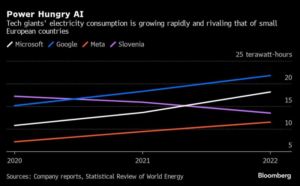
An article in the New York Times, Climate Forward section caught my eye…suggesting that AI Artificial Intelligence could soon use as much power as entire nations… eclipsing the power requirements of countries like Sweden, Argentina, and the Netherlands. That’s based on a projection of 134 TWh of power use for AI annually.
AI relies on thousands of specialized chips, mostly made by a company called Nvidia. The chips are at the core of the servers, and the Nvidia A100 servers are estimated to be used by 95% of the AI market. But they’re known to be “power-hungry beasts…” drawing 6.5 kW of power demand for the DGX A100 and 10.2 kW for the DGX H100… all in the name of computing, and AI.
OpenAI’s ChatGPT was introduced to the market and reached 100 million users in two months, “setting off an AI boom.” In short order, and still as a new market entrant, ChatGPT was already using as much power as 33,000 homes. It is estimated that a search driven by generative AI uses four to five times the energy of a conventional web search.
Trying to get a handle on units of AI energy. One image generation model uses 2.907 kWh “over 1,000 inferences.” In comparison, a smartphone takes 0.012 kWh to charge, so generating one AI image can use almost as much energy as charging your smartphone. Creating 1,000 images with a model like Stable Diffusion XL, results in as much CO2 emissions as driving a gas-powered car over four miles. In fairness, creating images is much more energy intensive than creating text. Apparently using smaller models for a specific task can also bump efficiency.
In addition to lots of power for computing, AI requires lots of cooling water to cool processors. When Google and Microsoft released their Bard and Bing large language models, some of their facilities had 20 -34% spikes in water use. Some Facebook AI researchers called the environmental effects of AI “the elephant in the room.”
MicroSoft pledged its Carbon Moonshot four years ago, to reduce its GHG emissions to zero by the end of the decade. But it reports that its emissions are rising… and some say AI is the reason. That year, 2020, was before the explosion in AI. Microsoft has planned to spend $50 billion expanding data centers in 2023 and 2024 to meet demand for its AI products.
The International Energy Agency reports that electricity from data centers, AI, and cryptocurrency was 2% of the global total in 2022. IEA projects a potential doubling by 2026, about 160 TWh on the low end, to 590 TWh… at least one Sweden and at most one Germany. And AI is not the only growth area… think electric vehicles, heat pumps, and electrification of factories.
In related news, California is the first in the nation. It has recently ushered in a new set of climate disclosure laws. All companies greater than $500 million in sales volume must disclose their “footprints” by 2026, plus their supply chain’s footprint by 2027. Thus OpenAI and Google will have to be transparent about climate risks and impacts.
There has been some legislative action on this wildcard energy use: U.S. Representative Ed Markey of Massachusetts introduced the Artificial Intelligence Environmental Impacts Act of 2024. It would direct the National Institute for Standards and Technology to collaborate with academia, industry, and civil society to establish standards for assessing AI’s impact.
So what might make AI more lean and green? Sustainable practices include measuring and publicly reporting energy and water use; developing energy-efficient hardware, algorithms, and data centers; and powering AI only with renewable energy.
Climatarians and the Quest for Climate-Friendly Food

An article in a Climate Resolve newsletter caught my attention… eating “climate friendly.” This got me revved up! CR mentions a book, “Cool Food, Erasing Your Carbon Footprint One Bite at a Time” by Thomas Kostigen and Robert Downey, Jr. Sounds interesting. It presents the power of ancient grains, farming techniques, why meal kits make sense, the cool food revolution, and more.
Some months ago, EcoMotion focused on various diets – vegetarian diets in particular. But we did not cover “climatarians.” So now we do! What distinguishes a climatarian’s pallet? It is designed to be healthy, climate friendly and nature friendly. Perhaps it’s one step past flexitarian: It allows one to periodically, sparingly eat meat and other foods that generate a lot of carbon emissions.
Meat-based diets, generally, have twice the carbon footprint of a vegetarian diet. Meat and dairy account for 14.5% of the global greenhouse gas emissions. But some veggie foods have big impacts too, like major water use to grow avocados and almonds. The biggest water consumer in California is our almond crop. Similarly, a pound of beef requires about 2,000 gallons of water to produce. A climate-friendly diet considers not just the food itself, but its water needs and its land-use requirements and impacts.
I dug into the Climates Network site, where the climatarian diet was reportedly introduced. The gist of it is simple: Avoid beef and lamb in everyday meals. It will save a tonne of CO2e a year. Swap beef and lamb for pork and poultry. Other features of the diet:
- Avoid processed meat
- Eat less meat overall
- Choose organic meat
- Buy local, seasonal fruits and vegetables
- Select sustainable fish
- Avoid waste, freeze leftovers etc
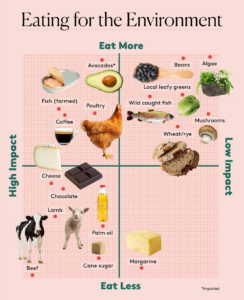
Food is a big deal, an important element of sustainability. Agriculture uses about half of all habitable land. It is responsible for a quarter of the world’s GHG emissions. The Western, standard meat-based diet produces about 7.2 kG (15.9 lbs) of CO2e per day, while a veggie diet produces 3.8 kG (8.4 lbs), and vegan 2.9 kG (6.4 lbs). Today’s annual global value of food emissions is 13.7 billion tons CO2e.
I learn about Coolfood.org… an organization “making climate action simple and delicious.” It provides consulting for institutional meals, urging the transition to plant-rich foods. Coolfoods works with clients like Sodexo to provide healthier, more sustainable foods for schools. Sodexo is rolling out a “blended burger” to curb GHG emissions. Coolfoods has worked with the City of Milan, Italy, helping it to use its purchasing power, shifting its food culture, and reducing emissions. MAX burgers, joined Coolfoods and has reduced its per-calorie emissions by 28.2%.
Separately, Coolfoods is also the name of an initiative of the World Resources Institute (WRI). It certifies meals as Low Carbon Certified. How does it do this? Using a meal’s ingredients list, WRI calculates a dish’s carbon footprint by analyzing the agricultural supply chain and land used to produce the meal. If the carbon footprint falls below an established per-meal threshold,and meets nutritional standards, it is certified as a Coolfoods Meal. In the United States, the threshold for breakfasts is 3.81 kG (8.4 lbs) CO2e/portion… and for lunches and dinners it is 5.71 kg (12.6 lbs) CO2e/portion.
Lufthansa’s Environmental Cost Surcharge

Here’s an interesting development for aviation related to climate: Lufthansa, the airline which is investing heavily in climate protection and which has aggressive goals, says it cannot keep up with regulations and the costs of compliance. It cites the heavy costs are complying with the European Union’s requirements for blends for sustainable aviation fuels, and paying into the carbon offsetting and reduction scheme for international aviation.
Lufthansa says that it cannot fully absorb rising costs imposed by regulations in its ticket prices. Thus, it has introduced and now has imposed an “Environmental Cost Surcharge.” It pertains to all flights sold and operated by the Lufthansa Group departing from 27 European Union countries and the United Kingdom, Norway, and Switzerland. The fees will range from $1 – 78 dollars.
In terms of climate protection, Lufthansa is on the go. It has a target to be carbon neutral by 2050. It is committed to halving its 2019 emissions by 2030. Its fleet modernization involves more than 250 new aircraft, each one more efficient, cutting emissions by ~30%. The company is working with Sustainable Aviation Fuels (SAF), in line with the EU’s “Fit for 55” climate protection program, which mandates increasing SAF blending quotas, starting at 2% in 2025 and reaching 70% by 2050.
Lufthansa is also looking at cutting-edge technologies, like AeroSHARK, an aircraft surface film inspired by sharkskin that reduces drag and lowers fuel consumption, thus emissions. Lufthansa is also focused on flight operations, maximizing efficiency through route and passenger optimization. At the end of 2023, Lufthansa’s carbon dioxide emissions were approximately 88 grams (3.1 ounces) per passenger kilometer… a slight decrease from the prior year.
EU’s Emissions Trading System controls and limits emissions through certificate trading within the European Economic Area. The International Civil Aviation Organization was established in 2016 and requires airlines to purchase certificates for offset growth-related CO2 emissions in international aviation. The system aims to offset emissions exceeding ICAO’s baseline. Lufthansa must comply with similar systems in the United Kingdom and Switzerland.
Flanigan’s Ego-Logic Podcast Updates
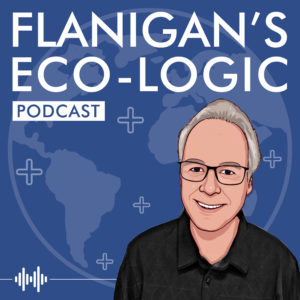
Use the links below to check out our recent podcasts. And you can always go to Spotify and type in “Ted Flanigan” to find our library of podcasts.
Recently Released:

In EcoNet News, Volume 26, Issue #6, Ted shares his highlights from his trip to San Francisco to cheer on Matlock, daughter Kristin’s boyfriend who was competing in the Escape from Alcatraz Triathlon. He also highlights that renewables provided more than 30% of all U.S. electrical generation in the month of April, a German research team testing new module concepts, integrating solar into sound walls along busy highways and railways, integrating Energy Vault’s gravity energy storage (GES) into skyscrapers, Kit Carson Electric Cooperative is in northern New Mexico’s clean and green position, AI’s energy intensity, the quest for climate-friendly food, and Lufthansa’s environmental cost surcharge.
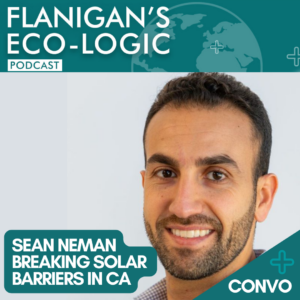
In this episode of Flanigan’s Eco-Logic, Ted speaks with Sean Neman, Founder and CEO of Cal Solar Inc. Cal Solar Inc. proudly delivers reliable, full service renewable energy solutions for new construction, existing buildings, and retrofit projects throughout California. Their experienced in-house team of designers, engineers, and installers is equipped to deliver renewable energy solutions for multifamily, commercial/industrial, and public works projects of any size. To date, they have successfully completed 600+ large-scale renewable energy projects, 200+ prevailing wage projects, and worked within 13 electric utility territories throughout the state.
Sean has been an entrepreneur and CEO in the renewables and energy efficiency construction space since 2008. Since founding Cal Solar Inc, Sean has executed $150MM in such projects and has led the company through continuous exponential growth, breaking through the barriers to solar in California, proving that rooftop solar is alive and well in Southern California.
He and Ted discuss Cal Solar Inc.’s diverse portfolio of projects, including the installation of what at the time was the tallest Solar Water Heating system in the world, atop the 42nd floor of 399 Fremont Street in San Francisco. They also focus on Panel-Level Energy Storage technology that Cal Solar is deploying.
Sean concludes by sharing the sentiment with Ted that the “solar coaster” is an interesting one, especially with so many policy changes across the board, but the industry in California is the industry to join. There is still tremendous opportunity and a need to tap this free, renewable resource.
